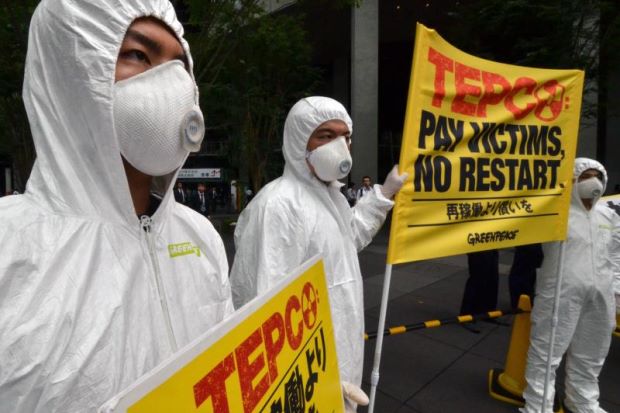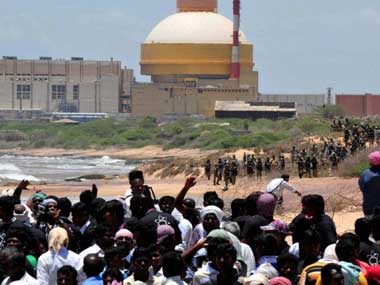
Blog
-
Geiger Readings for June 27, 2014
Ambient office = 89 nanosieverts per hourAmbient outside = 51 nanosieverts per hourSoil exposed to rain water = 64 nanosieverts per hourGala Apple from Top Foods = 77 nanosieverts per hourTap water = 86 nanosieverts per hourFiltered water = 64 nanosieverts per hour -
Nuclear Reactors 138 – Strong Public Protests in Japan Against Restarting Their Nuclear Reactors
I have blogged extensively about the nuclear disaster at Fukushima and its aftermath. I think it is very important for the world to understand all the different kinds of repercussions from the disaster. In addition to the nuclear materials that were released into the environment, there have been political impacts, economic impacts, social and psychology impacts, etc. I think it is important for people to know just how extensive the disruption to a society can be when there is a major nuclear accident.
The Japanese government under Prime Minister Abe has made nuclear power in Japan and nuclear technology exports a centerpiece of efforts to stimulate the Japanese economy. The government has not been completely forthcoming with the Japanese people about the causes of and the damage caused by the Fukushima disaster. Recently, laws have been passed to suppress criticism of the government over the Fukushima disaster. Any reporters who talk about problems connected to Fukushima can be arrested if they are not part of the government approved pool of reporters. The government wants to restart the Japanese nuclear reactor fleet but understands that a majority of the Japanese public is strongly opposed to any use of nuclear power in Japan. A new watchdog agency has been created for regulating nuclear power in Japan and its requirements are much more stringent than pre-Fukushima requirements.
Hundreds of thousands of Japanese citizens have protested Japan’s plan to restart the forty eight nuclear reactors that have been turned off since the Fukushima disaster in March of 2011. Recently, protesters have disrupted TEPCO shareholders meetings demanding that TEPCO abandon plans to restart nuclear power reactors at power plants other than Fukushima. Some of the protesters wore full body radiation protection suits to call attention to the fact that evacuated residence of Fukushima must wear such suits to visit their old homes. There are estimates that some Fukushima residents may have to wait for decades to return to their homes if they can return at all.
Some TEPCO shareholders are concerned that the nuclear reactors in their local areas may be unsafe and could be prey to disasters like Fukushima. There were calls for TEPCO to abandon nuclear power plants completely and replace them with renewable energy generation. Unfortunately for the protesting shareholders, a majority of TEPCO stock is currently owned by a special fund that the government set up to rescue TEPCO. Given the official position of the Abe government, it is highly unlikely that the proposal for TEPCO to abandon nuclear power will pass with the shareholder vote.
Japan is very poor in fuels such as coal, oil, natural gas and uranium. On the other hand, Japan is very rich in possible alternative and renewable sources such as wind, tide, and geothermal. With their sophisticated research facilities and industrial base, Japan could be a world leader in renewable energy. However, it would take a major push by the Japanese government and, right now, the Japanese government is backing nuclear power.
-
Radiation News Roundup June 26, 2014
TEPCO has begun the further decontamination of the first floor of the Fukushima Unit 3 reactor building. fukuleaks.org
TEPCO finally admitted the possibility that contaminated water penetrated to the deep layer of the ground. fukushima-diary.com
The Finnish nuclear regulator needs another six months to review Posiva’s application to build a waste encapsulation plant and a final repository at Olkiluoto. world-nuclear.org
PPL Corp. shut down Unit 2 at its Susquehanna nuclear plant Wednesday as monitoring data indicated the potential for further cracking in its turbine blades. nuclearstreet.com
-
Geiger Readings for June 26, 2014
Ambient office = 85 nanosieverts per hourAmbient outside = 101 nanosieverts per hourSoil exposed to rain water = 120 nanosieverts per hourGala Apple from Top Foods = 87 nanosieverts per hourTap water = 71 nanosieverts per hourFiltered water = 63 nanosieverts per hour -
Nuclear Reactors 137 – New Indian Government is Stongly Commited to Nuclear Power
India has a robust civilian nuclear program in addition to its nuclear arsenal. India has not signed the international nuclear non-proliferation treaty. This raises concerns when India wants to purchase nuclear technology from other countries. There is a fear that India will convert peaceful nuclear technology to military uses in their nuclear weapons program.
India has recently announced that it will sign an agreement with the International Atomic Energy Agency (IAEA) which will allow the agency to inspect civilian nuclear installations. India wants access to foreign nuclear technology and is signing the agreement as “a signal of our commitment to abide by our international obligations.” India had signed a previous agreement with the IAEA in 2008 which opened up nuclear commerce with other countries but critics attacked this earlier agreement as not providing sufficient safeguards against conversion of civilian technology to military uses.
Analysts of the new agreement say that it is an indication that the new government in India is interested in expanding imports of civilian nuclear technology from the United States and Japan. India has massive energy shortages that desperately need to be addressed. In his first speech after his election, Prime Minister Modi has promised to make nuclear power a priority for India. India is seeking billions of dollars for investment in new nuclear power plants. Modi will travel to Japan and the US this summer. Both of these countries have expressed interest in increasing nuclear technology cooperation with India.
Investment in Indian nuclear power plants has been low in recent years. Part of the reason is that there is a strong nuclear liability law that scared off some foreign investors. India already has deals with France and Russia for nuclear technology but just signed a new deal with a US company this year. India is planning to bring several new nuclear power plants online in the coming decade. Greater nuclear cooperation with the US is part of this plan. India intends to get twenty five percent of its electricity from nuclear power by 2050.
India is investing heavily in nuclear power and intends to become a leader in the global nuclear industry. They have worked on fast breeder reactors for years. In addition, they are working on the development of thorium reactors for power generation. India has a great deal of thorium that will be easy to access. There are still many technical problems that must be solved in order for thorium reactors to be put into commercial use.
Critics of Modi’s focus on nuclear power are afraid that the Modi government has less concern for environmental dangers than the previous Indian government. There have been indications that the Modi government may use its power to marginalize environment groups and groups pushing alternative energy sources. If India forges ahead with a vigorous nuclear program while turning its back on environmental concerns and alternative energy, I am afraid that there will be major nuclear accidents and a severe public backlash against nuclear power in India.
Protest outside the Indian Kudankulam reactor:
-
Radiation News Roundup June 25, 2014
Still extremely high level of Cs-134/137 is measured from agricultural products in Fukushima, according to Fukushima city government. fukushima-diary.com
The US Nuclear Regulatory Commission has revealed the cause of a fatal industrial accident that took place during refurbishment work last year at Entergy’s Arkansas Nuclear One plant. world-nuclear-news.org
-
Geiger Readings for June 25, 2014
Ambient office = 98 nanosieverts per hourAmbient outside = 89 nanosieverts per hourSoil exposed to rain water = 105 nanosieverts per hourGala Apple from Top Foods = 105 nanosieverts per hourTap water = 113 nanosieverts per hourFiltered water = 104 nanosieverts per hour -
Nuclear Reactors 136 – The 2014 Washington State Democratic Platform has a Nuclear Power Plank
I usually post Geiger readings and links to articles every day of the week and a blog essay every Monday through Friday. I have not posted anything for several days because I have been traveling. I spent this last weekend in Spokane, Washington at the Washington State Democratic Convention. Most of the time was dedicated to approving the Washington State Democratic Platform. I was quite impressed by how comprehensive, rational and progressive the Platform is. There were a few issues that triggered arguments about whether to retain or remove a particulate plank but most of the Platform was readily adopted. One issue in particular that led to a very passionate argument was the plank of the Platform that dealt with nuclear power.
The nuclear power plank read: “Permitting expansion of nuclear power only with strong environmental protection, when safe, long-term waste management can be guaranteed and projects are shown to be cost effective without public subsidies.”
There were two speakers in favor of retaining the plank. One speaker argued passionately that less rainfall in Washington could mean less hydropower and that nuclear was the only viable choice for reliable and carbon neutral power generation because wind and solar would not be able to supply the electricity that society requires.
There were two speakers against retaining the plank. One speaker railed against nuclear power and said that our Democratic Platform should not support nuclear power in any way. It was also pointed out that Seattle City Light was backing out of support for the only operating nuclear reactor in Washington State.
It should be obvious to anyone who has read my blog posts that I am strongly opposed to nuclear power. With respect to climate change, it takes a lot of energy to mine and refine uranium. It also takes a lot of concrete to construct a nuclear power plant. Some estimates suggest that it may take up to fifteen years of operation before a nuclear power plant has paid off its carbon debt. With respect to environmental threats, nuclear power has already resulted in areas being permanently evacuated because of radioactivity released by nuclear accidents. Fukushima is still causing environmental problems two years after the accident. Since Yucca Mountain was cancelled as the site for a permanent nuclear waste repository, the latest estimate is that a permanent repository won’t be available in the United States until 2050 at the soonest. Wind and solar energy generation is beginning to beat out nuclear projects on a strictly financial basis on a level playing field.
After listening to pro and con arguments about the plank, I concluded that I would rather leave it in the Platform. I do not believe that the conditions in the plank can be met by any new nuclear projects. On the other hand, the plank does put us on record with respect to what we require of any new nuclear projects in our state. In the end, I think it is better to have qualified support for nuclear projects as opposed to no plank at all in the Platform that addresses nuclear power.
-
Radiation News Roundup June 24, 2014
-
Geiger Readings for June 24, 2014
Ambient office = 91 nanosieverts per hourAmbient outside = 119 nanosieverts per hourSoil exposed to rain water = 119 nanosieverts per hourGala Apple from Top Foods = 114 nanosieverts per hourTap water = 136 nanosieverts per hourFiltered water = 113 nanosieverts per hour






